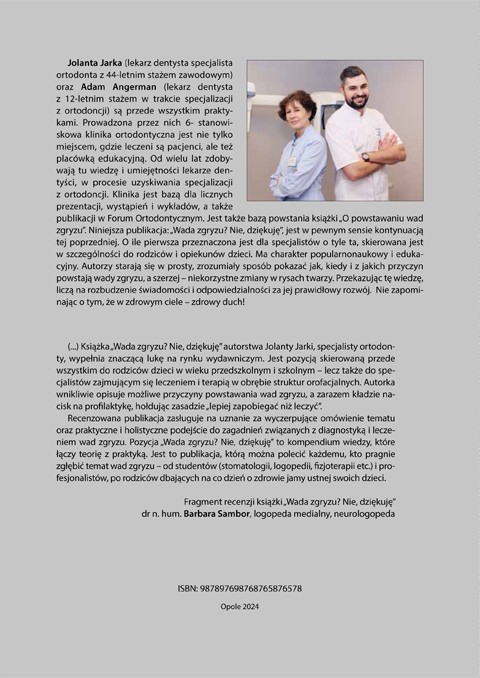

The book "Malocclusion? No, thank you. A guide to understanding bite problems. A Guide for Parents and More" is, in a sense, a continuation of the book "On the Development of Malocclusions." It is the second installment in the series, this time aimed at parents and guardians of children. It is educational and written in a popular science style.
From the summary….
Remember:
The prevention of malocclusion involves eliminating factors known to disrupt the proper growth and development of craniofacial structures, starting from the first days of a child's life.
In orthodontics textbooks, the causes of malocclusion are listed as a genetic background and environmental factors, which include:
If trauma is defined as the application of sudden force, then this cause accounts for a mere fraction of a percent of all malocclusions. However, it can be argued that, in reality, all the factors listed are forms of trauma acting on the masticatory system, just over a long period and slowly—not dynamically. This context, aside from ethnic traits over which we have no influence, should direct our attention to the potentially damaging effects of all the factors mentioned.
Early intervention is the elimination, by multidisciplinary teams, of existing disorders in the youngest children (up to approx. 3 years of age). This involves treating dysfunctions and eliminating all types of parafunctions.
Early treatment involves unlocking proper growth in children where deformation of the dental arches and alveolar processes has occurred—this includes selective grinding of the cusps of primary teeth in a crossbite (even if it involves just a single tooth) and the use of a cemented acrylic bite plane or other simple solutions. It also involves using simple appliances to restore normal occlusion, such as a vestibular screen (for open bite, distal occlusion), an upper Schwarz plate, or appliances with a Hyrax screw for palatal expansion. Simultaneously, it is essential to effectively treat the underlying causes of the disorders, if they are still active, such as respiratory and tongue-related dysfunctions. This primarily applies to preschool-aged children. At this stage, preventive measures can and should be implemented, such as space maintainers in case of premature loss of primary teeth and monitoring the transition from primary to permanent teeth—which is especially important during the early school years. This is the time when dento-alveolar malocclusions become anchored in the skeletal structure if developmental norms have not been restored by this point. Appliances like the Hyrax expander with a facemask, cervical headgear, the Twin-block, and other solutions can quickly and effectively harmonize facial features. They must be supported by correcting the muscular environment. Only then is it possible to genuinely change the growth pattern from abnormal to normal, which is a prerequisite for the long-term stability of treatment results without the need for years of retainer wear.
Delaying the first visit to the orthodontist until the final stages of the mixed dentition period in children and adolescents effectively closes the door on the opportunity to restore normal development. Restoring the proper function of all systems by various specialists is absolutely necessary and requires an understanding of the mechanisms of their interaction, without overstepping professional boundaries.
The book can be purchased at our practice or received by mail after paying 50 PLN + shipping costs (InPost - 15 PLN, Courier - 16 PLN) to the ING Bank account: 49 1050 1504 1000 0090 7458 1118 .
Those interested in shipping are asked to contact us by phone or email to arrange shipping details or to provide information for an invoice, if required.
We use cookies
We use cookies to make your experience on our websites better, as well as for statistical and advertising purposes. By not blocking these files, you consent to their use and storage on your device. Please remember that you can change your browser settings to block cookies at any time. For more information, please see our privacy policy.